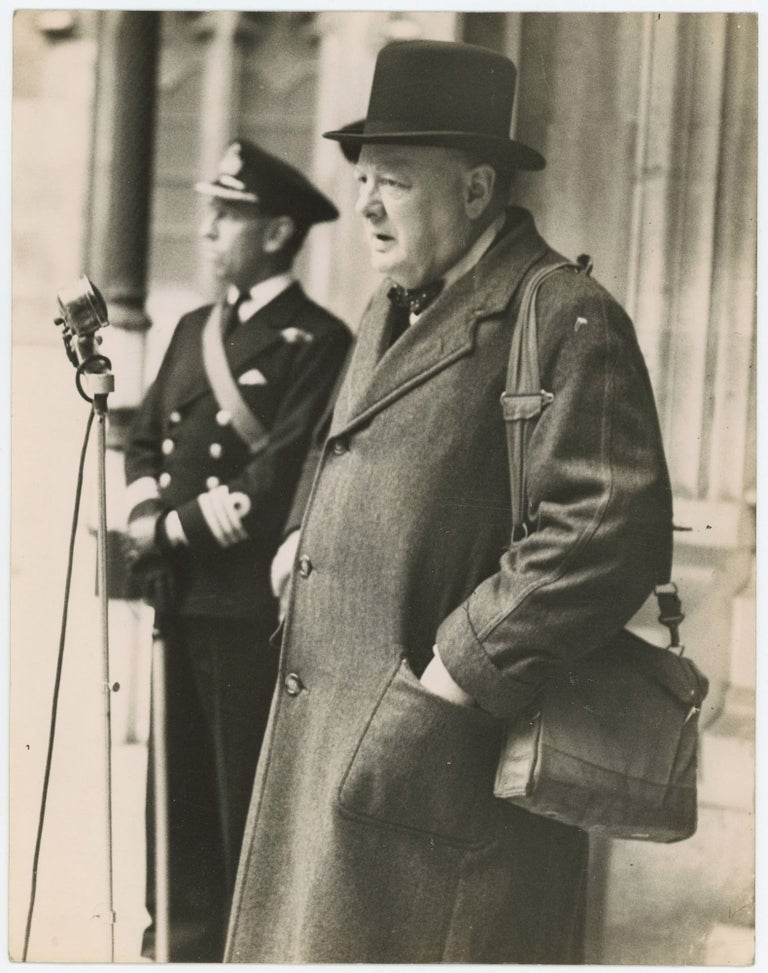An original wartime press photograph of Prime Minister Winston S. Churchill on 12 May 1942 addressing the Parliamentary Home Guard in London while carrying his gas mask
London: Planet News Ltd., 13 May 1942. Photograph. This original press photograph captures Prime Minister Winston S. Churchill on 12 May 1942 delivering a speech to the Parliamentary Home Guard while carrying his gas mask in its bag. The gelatin silver print on matte photo paper measures 9.5 x 7.5 inches (24.1 x 19 cm) . Condition is very good. The paper is crisp, clean, and free of scuffing with only light bruising to the corners. The verso bears the copyright stamp of “Planet News Ltd”, a received stamp dated 13 MAY 1942, and a typed caption titled “THE PRIME MINISTER – CARING [sic] HIS GAS MASK – INSPECTS PARLIAMENTARY HOME GUARD.” The caption reads, “Mr. Winston Churchill, inspected detachments of the Parliamentary Home Guard in London. The detachment included members of Parliament, messengers and men of the staff of both Houses and is responsible for guarding the whole Parliament area. PHOTO SHOWS: Mr. Churchill addressing the Home Guard after the inspection.” The caption terminates with the date “12th May 1942”.
When Churchill became Prime Minister on 10 May 1940, the war for Britain was not so much a struggle for victory as a struggle to survive. The possibility of invasion was a genuine concern. Anthony Eden proposed to the War Cabinet the formation of Local Defence Volunteers and on 14 May he delivered a radio broadcast calling for men between the ages of 17 and 65 to volunteer to protect their nation. Churchill found the word Local to be uninspiring and had the title changed to Home Guard. By summer 1.5 million Britons had joined. “Men and women worked night and day making them [weapons] fit for use. By the end of July we were an armed nation, so far as parachute or airborne landings were concerned. We had become a ‘hornet’s nest’.” (WSC, WWII, Vol.II, p.238) Over the course of the war the initially untrained and sparsely equipped force acquired uniforms, ranks, and formal military training. As invasion became less of an imminent threat, the Home Guard’s duties shifted to the location and disposal of unexploded bombs and home front military relief to free the Service members for overseas duties.
Churchill’s first year in office had seen, among other near-calamities, the Battle of the Atlantic, the fall of France, evacuation at Dunkirk, and the Battle of Britain. By mid-1942, two days before this image was captured, he was able to say "We have reached a period in the war when it would be premature to say that we have topped the ridge, but now we see the ridge ahead.” (speech of 16 May 1942) But even as it became less of an urgent need the Prime Minister who had bestowed its name remained attentive to the Home Guard. On 14 May 1943, the third anniversary of the formation of the Home Guard, Churchill delivered a speech in thanks of the nation’s defenders. “We must not overlook, or consider as matters of mere routine, those unceasing daily and nightly efforts of millions of men and women which constitute the foundation of our capacity to wage this righteous war…The degree of the invasion danger depends entirely upon the strength or weakness of the forces and preparations gathered to meet it… You Home Guardsmen are a vital part of those forces”. The Home Guard was formally disbanded on 31 December 1945.
This press photo originated from Planet News Ltd. press agency. During the first half of the twentieth century, photojournalism fundamentally changing the way the public interacted with current events. Newspapers assembled expansive archives, physical copies of all photographs published or deemed useful for potential future use, their versos typically marked with ink stamps and notes providing provenance and captions. Photo departments would often take brush, paint, pencil, and marker to the surface of photographs themselves to edit them before publication. Today these photographs exist as repositories of historical memory, technological artifacts, and often striking pieces of vernacular art. Item #005249
Price: $225.00


